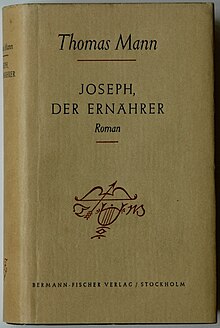|
Joseph and His Brothers
Joseph and His Brothers (German: Joseph und seine Brüder, pronounced [ˈjoːzɛf ʊnt ˌzaɪ̯nə ˈbʁyːdɐ]) is a four-part novel by Thomas Mann, written over the course of 16 years. Mann retells the familiar stories of Genesis, from Jacob to Joseph (chapters 27–50), setting it in the historical context of the Amarna Period. Mann considered it his greatest work.[citation needed] The tetralogy consists of:
ThemesMann's presentation of the ancient Orient and the origins of Judaism is influenced by Alfred Jeremias' 1904 Das Alte Testament im Lichte des Alten Orients, emphasizing Babylonian influence in the editing of Genesis, and by the work of Dmitry Merezhkovsky.   Mann sets the story in the 14th century BC and makes Akhenaten the pharaoh who appoints Joseph his vice-regent. Joseph is aged 28 at the ascension of Akhenaten, which would mean he was born about 1380 BC in standard Egyptian chronology, and Jacob in the mid-1420s BC. Other contemporary rulers mentioned include Tushratta and Suppiluliuma. A dominant topic of the novel is Mann's exploration of the status of mythology and his presentation of the Late Bronze Age mindset with regard to mythical truths and the emergence of monotheism. Events of the story of Genesis are frequently associated and identified with other mythic topics. Central is the notion of underworld and the mythical descent to the underworld. Jacob's sojourn in Mesopotamia (hiding from the wrath of Esau) is paralleled with Joseph's life in Egypt (exiled by the jealousy of his brothers), and on a smaller scale his captivity in the well; they are further identified with the "hellraid" of Inanna-Ishtar-Demeter, the Mesopotamian Tammuz myth, the Jewish Babylonian captivity as well as the Harrowing of Hell of Jesus Christ. Abraham is repeatedly presented as the man who "discovered God" (a Hanif, or discoverer of monotheism). Jacob as Abraham's heir is charged with further elaborating this discovery. Joseph is surprised to find Akhenaten on the same path (although Akhenaten is not the "right person" for the path), and Joseph's success with the pharaoh is largely due to the latter's sympathy for "Abrahamic" theology. Such a connection of (proto-)Judaism and Atenism had been suggested before Mann, most notably by Sigmund Freud in his Moses and Monotheism, which had appeared in 1939, just before Mann began work on the tetralogy's fourth part—although in the last installment of Mann's work, Akhenaten is postulated as the Pharaoh of the Exodus contemporary of Moses, while Mann in his novella "Das Gesetz" (1944) casts Ramesses II in that role. As Joseph is saved from the well and sold to Egypt, he adopts a new name, Osarseph, replacing the Yo- element with a reference to Osiris to indicate that he is now in the underworld. This change of name to account for changing circumstances encourages Amenhotep to change his own name to Akhenaten. The tetralogy closes with a detailed account of Jacob's famous Blessing of his sons and their tribes, his death and the funeral. The characters of the individual brothers are determined by epithets taken from the text of the Blessing of Jacob throughout the details; thus Reuben is "turbulent as the waters" (and associated with Aquarius by Jacob). Simeon and Levi are known as the "twins" (and associated with Gemini), even though they are a year apart, and portrayed as violent bullies. Juda is a lion (Leo), and inherits Abraham's blessing since Jacob disrobes his elder brothers of their birthright. Zebulun shows predilection for Phoenicians and seafaring. Jacob calls "bony" Issachar a donkey to evoke Asellus, γ and δ of Cancer. Dan is sharp-witted and "suited as a judge" (Libra). Asher is fond of dainties. Joseph is blessed by Jacob in his dual aspect of male (Dumuzi, god of seed and harvest), with reference to Taurus, and female (since for Jacob, his beloved Rachel lives on in Joseph, and in his affinity with the nourishing Earth), with reference to Virgo. As Jacob comes to Benjamin, his strength is almost gone, and with his last breath he rather incoherently compares his youngest son with a wolf, partly because of Lupus in Scorpio.[clarification needed]
Chapter structureEach one of the four books is divided into seven chapters, each of which is divided into further subdivisions. The first and last book also comprise a “Prelude” each. The Tales of Jacob
Young Joseph
Joseph in Egypt
Joseph the Provider
Editions and translations
See alsoReferences
External links |
||||||||||||||||



